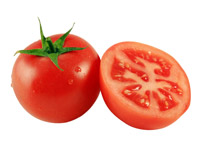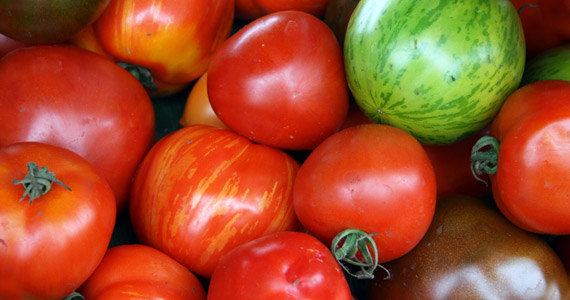Growing tomatoes

Growing tomato

The tomato is the most commonly grown garden vegetable in the Netherlands and is not just a fruit. The tomato has fans! There are enthusiasts who recognize dozens of species by eye alone and fully enjoy the different flavors.
Is a tomato a vegetable or a fruit?
The question that has been asked in many discussions! The distribution of fruit and vegetables has mainly arisen from a practical point of view. From a botanical point of view, the terms fruit and vegetables do not exist. The correct name for the tomato is actually a fruit. Botanically speaking, fruits, flowers, leaves or stems all fall under the category of vegetables.
- Vegetable: refers to all edible parts of a plant.
- Fruit: is always a (false) fruit of the plant
We often call what is mainly prepared in the pan vegetables, what is eaten 'out of hand' we know as fruit. From a practical point of view, tomatoes can therefore best be classified as a vegetable.
Are tomatoes healthy?
Tomatoes have many positive properties: they are low in calories, rich in various vitamins and contain antioxidants in the form of lycopene.
Scientists have shown that lycopene would protect against cardiovascular disease and even against certain cancers. Lycopene is never alone in its healing role, but the compounds that lycopene forms with other substances such as phytoenes, phytofluenes and other carotenoids are of great importance for the functioning of antioxidants in the body.

As a tomato paste, lycopene can also slow cell aging, resulting in fewer wrinkles! Lycopene is similar to the dyes that give oranges, carrots, salmon, shrimps and flamingos their distinctive pink or orange color, for example.
Lycopene leaves the body within 24 hours, but remains for a while. If you drink a few liters of tomato juice daily for an extended period of time, your skin can even turn orange or pink, just like a shrimp or a flamingo.
A tomato is also very rich in vitamin C. Very healthy!
Which tomato varieties are there?
In general, tomatoes can be divided into two varieties: determinate and indeterminate. Certain tomato plants grow until they reach a certain height and then stop growing on their own. This species forms one or more tendrils, which keeps the plant more compact. The tendrils of the indeterminate species just keep growing and growing to fill the available space. You often have to support this species.
The space you have available for growing tomatoes is often the deciding factor in determining the type of tomato you want to grow. Growing tomatoes indoors is quite easy thanks to the range of mini tomato varieties. A mini tomato plant only needs a pot of 10 to 15 cm. Different varieties are often grown in vegetable gardens, so that you can harvest and eat almost all year round. Whether grown indoors or outdoors, tomatoes are easy to grow and harvest.
We have had good experiences with the following varieties:
Cherry tomatoes
The mini cherry tomato Minibel (Solanum lycopersicum cv) is a tomato variety that produces an abundance of small, sweet tomatoes. This quickly branching plant grows to about thirty to forty centimeters and therefore feels great in a pot.
With the Minibel variety it takes about ten weeks from sowing until you can harvest. This plant is suitable for growing at home. Indoors or outdoors, in a grow tent, in the garden or on the balcony. The cherry tomato Minibel is suitable for growing on potting soil, coconut grit, rockwool and hydroponics. You can use all specialized CANNA product lines: TERRA, COCO, AQUA, HYDRO and BIOCANNA.
Vine tomatoes
The mini vine tomato Yellow Pear (Solanum lycopersicum cv) is a tomato variety that produces small, sweet tomatoes. The special thing about this variety is that the fruits are yellow and have the shape of a pear. This plant can grow very high and is therefore less suitable for cultivation in a pot. You will have to thieve and cut this vine tomato regularly.
The process from sowing to harvest takes about eight weeks for the Yellow Pear. The yellow truss tomato is suitable for growing on potting soil, coconut grit, rockwool and hydroponics. CANNA has developed specialized product lines for each of these cultivation methods; TERRA, COCO, AQUA, HYDRO and BIOCANNA.
Sow and germinate
Let the seeds of the tomatoes germinate in good sowing soil. You can make this yourself by mixing three parts of potting soil with one part of sand. If you want to use an optimal sowing soil, choose CANNA Terra Seedmix. Fill a coverable seed tray with this soil. Moisten the soil and let it acclimatize to a temperature of about 20°C.
Divide the seed of the tomatoes over the seed tray, fill it with a maximum of half a centimeter of sowing soil or CANNA Terra Seedmix and cover the tray with, for example, a plastic lid or glass plate. This will maintain the temperature and prevent dehydration. Air the soil occasionally during the day by leaving the cover plate ajar, for example by placing a stick under the plate.
Tomato seedlings need a lot of sun, if you don't have a sunny window, use a pre-growth fluorescent or energy saving lamp. If you use a grow tent, you can sow directly in it. Be careful with the light. If it is too bright, the young plants can dry out or even burn.
Moving seedlings
When the first pair of leaves appears (see picture), about fourteen days after sowing, it is time to move the seedlings to a larger pot. We also call this spitting out. Place the plants in pots of 1.5 liters and a diameter of twelve centimeters, filled with a high-quality substrate such as CANNA Terra Professional, Terra Professional Plus or CANNA Coco. If you go for organic cultivation, choose certified potting soil such as the BIOCANNA Bio Terra Plus. Try to damage the carrots as little as possible to avoid stress.
Transfer to larger pot
About two to three weeks after transplanting it is time to pot your plant. Place the plant in a larger pot, with a capacity of three to six litres. This ensures that the tomato plants are stable and have an adequate moisture buffer that is large enough for the remaining duration of the cultivation. After about mid-May you can move the tomatoes outside, do this on a cloudy day to avoid a mess. Be aware that the risk of insects and diseases is greater outdoors.
Thieves, tying up and pruning
After the plant has created about six side branches, you should remove the top. Remove the offshoots in the axils of the leaves as much as possible (we call this thieves). Hanging offshoots can be supported with clips and sticks. This prevents the branches from breaking off due to the weight of the fruit. Branches that protrude too far can be cut off. The tomato plant will then continue to sprout from a leaf axil. When the plant is very compact and tomatoes hang in the shade of the lower leaves, you can remove these leaves. The tomatoes also color better when they hang in the light.
Watering
A tomato plant requires a lot of water. As a result, you have to check daily whether the pot is still sufficiently moist or – in the case of an aqua system – the water level is still high enough. It is better to water a lot once a week than a little daily. Once the pot has been so dry that the leaves of the plant have gone limp, give plenty of water so that the potting soil, coconut or rockwool can absorb itself completely. It is also good to do this if the plant gets very hard and dark leaves and hardly grows anymore.
Pollinate flowers
A tomato plant only produces fruit if the flowers are pollinated. In nature, bees and bumblebees do this. Because this is not so handy at home, you can also give nature a helping hand by tapping the flower branches or going with a brush along the stamens and pistils. The pollen is then released and pollination can take place. This will give you more and better shaped fruits.
Temperature, light and humidity
The tomato is originally a tropical plant. It feels at home with a daytime temperature of about 25°C and a nighttime temperature of about 20°C. At night the temperature should not drop below 16°C. The tomato plant needs fourteen hours of light per day for proper development. The ideal relative humidity (RH) is 70%. In a grow tent, the RH is usually a bit lower, around 45%. A small layer of water on the ground or a nebulizer can help to increase it.
Harvesting tomatoes
Tomato plants like warmth and they need a lot of nutrients. The shape of the fruit often varies, as does the color. There are of course red tomatoes, but also yellow, orange, salmon pink, striped and even green. After harvesting tomatoes, be careful not to refrigerate them. Even then they like warmth: always store tomatoes above 10 °C.
Diseases and plagues
Fungus gnats (peat flies) occur in almost every substrate, fortunately these are harmless to the tomato plant and disappear by themselves. Some plants can suffer from whitefly, aphids or other pests and diseases. You can prevent and combat this in an environmentally friendly way with CANNACURE. Check out our Pests and Diseases guide for more information.


